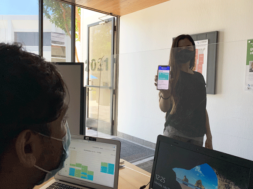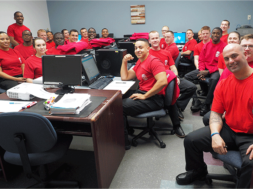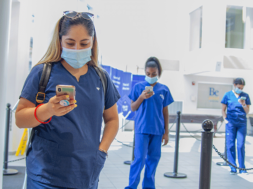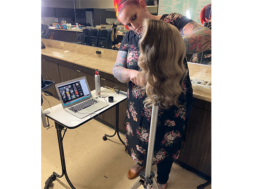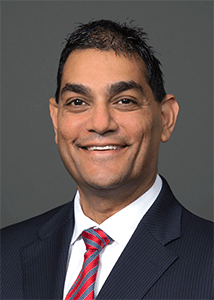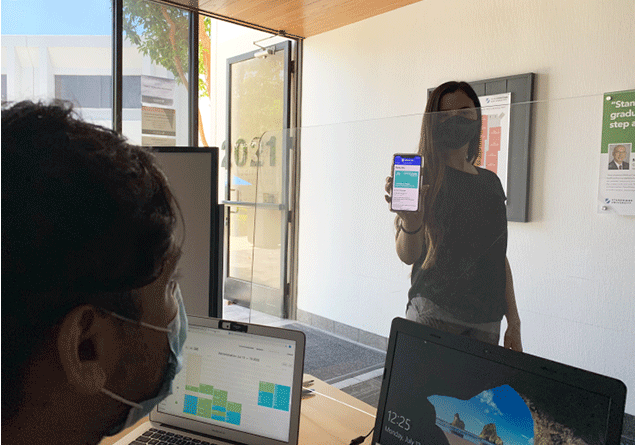
Campus Screening App, Cleaning Technology Help Bring Stanbridge University Students Safely Back to Campus
Written from an interview with Yasith Weerasuriya, President and CEO, Stanbridge University
With students in nursing, physical therapy, occupational therapy and veterinary science, one thing was clear to Stanbridge University when the coronavirus starting shutting down much of the world last spring. Their students needed to be back on-ground for essential lab and clinical learning, but only if it could be done safely.
Yasith Weerasuriya, president and CEO of Stanbridge University, said their students got back into their clinical settings starting May 1, thanks to exemptions in the California governor’s mandate that allowed essential healthcare workforce training institutions to continue unaffected by the stay at home mandate.
“We certainly followed all the best practices in social distancing, masks use and all the other additional protocols to make sure everyone was safe,” Weerasuriya said.
But Stanbridge University did much more.
Weerasuriya said their university deals with seven different accreditors for their programs, and flexibilities were made by everybody to provide a framework on what could be done with remote instruction during the pandemic, all in a cautious manner.
“You either had to pause lab/clinical instruction at that point, or in some way get back on the ground in a modified manner,” he said. “For us, it was very clear. We wanted to provide a safe pathway for students to continue with their education.”
If students were concerned about their health or about exposure to COVID-19, they could take a leave of absence with no penalty. However, only a few students took advantage of that, Weerasuriya said, as the university put in many steps to make students feel safe about returning to campus.
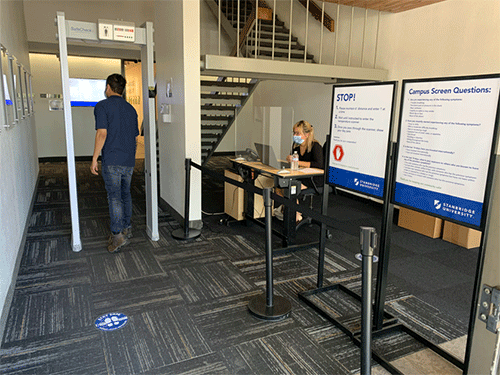 For one, Stanbridge put in thermal scanning stations at each of the entryways to their buildings that comprise its campuses. Students, staff and faculty walk through the body temperature detectors, called SafeCheck, which are manned at all times. If a high temperature was detected, the scanner had audible and visual alerts.
For one, Stanbridge put in thermal scanning stations at each of the entryways to their buildings that comprise its campuses. Students, staff and faculty walk through the body temperature detectors, called SafeCheck, which are manned at all times. If a high temperature was detected, the scanner had audible and visual alerts.
Two, they started using NanoSeptic coverings for highly used surfaces. The new technology improves the cleanliness of high-touch surfaces, he said, as NanoSeptic skins and mats turn dirty, high-traffic public touch points into continuously self-cleaning surfaces.
“It’s almost like a cape that you put around a door handle, but it uses light and nanocrystals to create powerful oxidation reactions. It kills the bacterium with the heat that is released at the nano level,” Weerasuriya said, adding that they applied the coverings to all door handles in restrooms, building entryways and classrooms.
In addition, the university started using UV cleaning robots, basically putting UV lights in the classroom for five minutes as the lights rotate and, in the process, kill germs. Stanbridge also uses electric ultra-low volume (ULV) wet fogging machines, which are also used in airplanes and on public transportation. You basically spray an ionized mist onto surfaces. This reaches hard to get to areas and provides more uniform sanitization. “When you wipe something, you can miss something,” Weerasuriya explained. “We use these units on a daily basis and deep clean in between classes and after classes.”
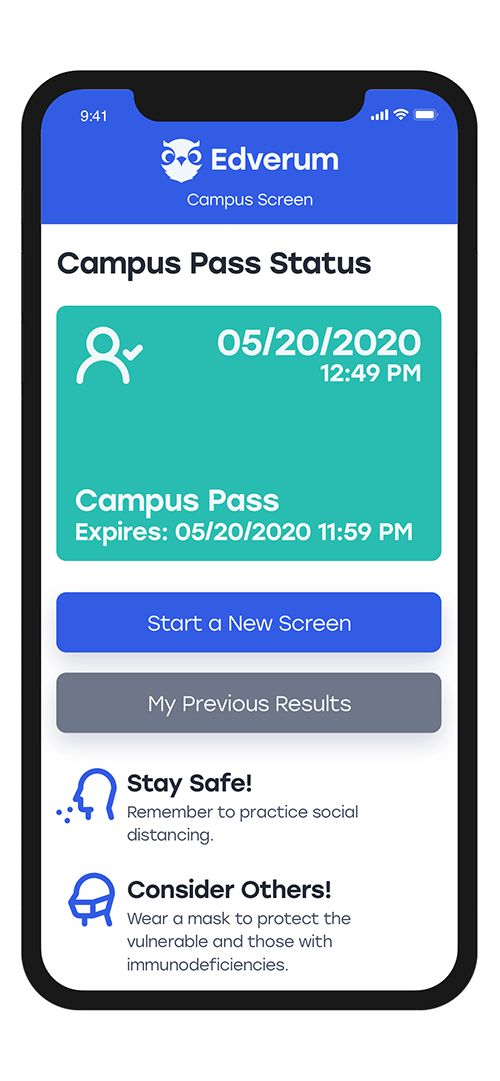 Weerasuriya said they were also concerned that if they were asking people to self-screen at the entryways to the buildings, an individual may potentially already be symptomatic, or developed symptoms quite literally on the way to the university and could bring COVID-19 in. “So we developed an app that would allow all of our community to self-screen at home before they got into the car,” he said. “It was a major task for our in-house software development team to do this.”
Weerasuriya said they were also concerned that if they were asking people to self-screen at the entryways to the buildings, an individual may potentially already be symptomatic, or developed symptoms quite literally on the way to the university and could bring COVID-19 in. “So we developed an app that would allow all of our community to self-screen at home before they got into the car,” he said. “It was a major task for our in-house software development team to do this.”
Inspired by an app that Brigham and Women’s Hospital in Boston, a Harvard teaching hospital, developed, it allows for efficient and quick self-screening, he said. They ensured that it met all the federal guidelines, and the Apple and Google stores additionally carefully vetted it to make sure that it met all the stringent standards for a health screen app.
“The Campus Screen app, which is available for free download at the Apple and Google stores, allows people to present a visual pass which is good for up to 8 hours to on-campus screeners, he said. All people have to do is hold up their phone and show the green day pass. And for those individuals screening at home with a yellow or red pass, it is a visual alert for them to seek additional medical attention. The Campus Screen app is available at no cost for any career school to download on the Apple and Google app stores.
Everything that the app recommends follows the Centers for Disease Control and Prevention guidelines. “If the screen says yellow, it tells the person to contact their healthcare provider,” he said. “If it’s red, it tells them with more urgency to go ahead and immediately seek medical attention. It’s as simple as that.”
The main advantage of the app is that it made entry into buildings easier and quicker since students, faculty and staff just had to show the green pass instead of answering questions or filling a questionnaire. However, they decided not to store specific student information from the app in their information system.
“We’re in California where there are very heavy regulations like the California Consumer Privacy Act,” Weerasuriya said. “This app only stores information on an individual’s phone. It doesn’t transmit it to third parties.”
Stanbridge also promulgated additional protocols for students testing positive on how to notify the university and how to go ahead and create a return pathway on campus with the appropriate documentation.
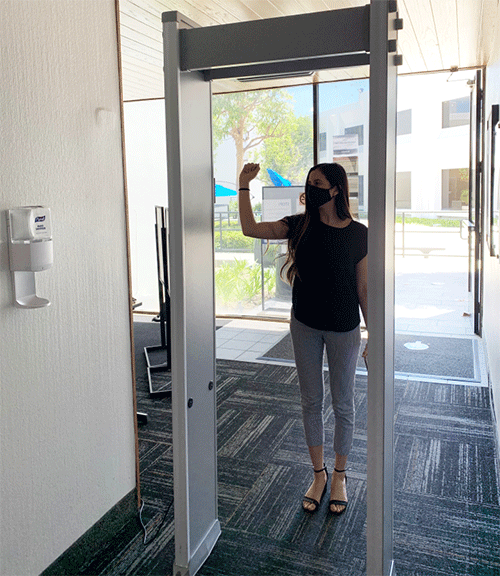 “Two weeks ago, we partnered with an organization to provide six days a week no cost drive-thru PCR COVID testing at one campus. At other campuses where we could not initiate onsite testing, we partnered with locations close by where our students can go for no-cost testing and the results are available within 24 hours.
“Two weeks ago, we partnered with an organization to provide six days a week no cost drive-thru PCR COVID testing at one campus. At other campuses where we could not initiate onsite testing, we partnered with locations close by where our students can go for no-cost testing and the results are available within 24 hours.
“This is a major benefit for us because our students are at clinical facilities ranging from skilled nursing facilities to acute care hospitals. Depending on what county the facility is in, the students would need to provide weekly, twice a month or monthly testing results in order to continue to do their clinical student rotations. For us, to make testing available on campus was a massive convenience.”
Stanbridge University also put infrared thermometers into every room that students occupy. So, if students were to develop symptoms while at school, they could just go to one of these stations without any kind of contact and take their temperature.
In addition, Stanbridge University has a full-time hall monitor who is constantly making sure that people are wearing masks and socially distancing.
Many people have become exhausted with wearing masks and social distancing. So, the biggest challenge was making sure that everyone is following protocols Weerasuriya said.
“Students sometimes would congregate outside of class,” he said. “We had to really go through an extensive training program to enforce social distancing
A newer challenge has been ensuring integrity through the assessment process. “We had to evaluate different vendors, from Examsoft to Examity to ProctorU to ProctorFree, to figure out how to make sure we could deliver exams at home in an integral manner,” he said. “You can imagine in a pre-licensure environment everybody is happy to test at home, but how do you monitor 30 students taking a test online in the same way as you would on ground?”
For example, one of their vendors, Examsoft, uses an artificial intelligence agent that at the start of the exam scans his or her government ID looks at the face to ensure it’s the right person and then locks the screen once verified he said.
“Then while you’re taking the test, it’s tracking your eyeballs,” Weerasuriya said. “If it notices movement, it immediately triggers in the recording to look at this part. There are certain triggers that are automatically reviewed within 24 hours by the team within Examsoft and escalated back to the school. If the person leaves the test, if they notice a phone, if they notice someone coming in, then we can go ahead and assess the integrity of that exam.”
Stanbridge University at a glance
- With three locations in Irvine, Alhambra, and Riverside, California, Stanbridge offers programs at the diploma,
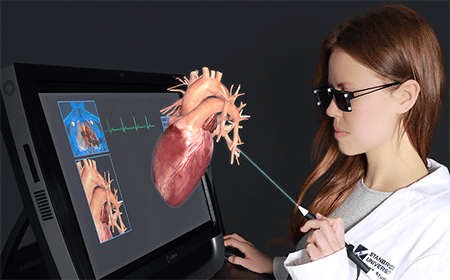 associate’s, bachelor’s and master’s degree levels in nursing, physical therapy, occupational therapy, veterinary science and healthcare administration.
associate’s, bachelor’s and master’s degree levels in nursing, physical therapy, occupational therapy, veterinary science and healthcare administration. - Stanbridge University was the first to bring SynDaver, synthetic human and synthetic surgical canine cadavers to the West Coast for hands-on training in anatomy.
- In partnership with Cornell University, Stanbridge University also brought the world’s first high-fidelity canine patient simulation unit to the West Coast.
- In 2015, the school opened the nation’s largest virtual reality lab for healthcare training featuring zSpace, virtual and augmented reality technology in an interactive, multi-sensory learning experience of 3D anatomical and biological models. The virtual reality lab includes the Anatomage Table, a technologically advanced visualization and virtual dissection system for full-scale human and animal anatomy and physiology education.
- Stanbridge’s award winning OutREACH program has several signature initiatives including the Root for Change program to plant 10,000 trees, ocean plastic retrieval, food security, animal welfare and engagement with disabled communities that include the Wounded Americans Experience SCUBA (WAVES).
- Stanbridge has been leading its student body during the current national discourse on diversity with a series of TED Circles and TEDx events on topics ranging from the beauty of skin in every color to women in leadership.
Without that assessment integrity, as well as their faculty members’ ability to engage students in an online environment, both in synchronous and asynchronous modes, Weerasuriya said they knew they’d have trouble downstream with students having knowledge deficits that were not identified early.
But if there is a silver lining in all of this, it’s that about 18 months ago Stanbridge piloted a virtual tutoring system. “We were finding that some of our students were having difficulty getting on campus due to commuting and childcare issues. So, we piloted a virtual tutoring program.” This was a good precursor to the remote online tutoring that has become a mainstay today.
Another silver lining of the pandemic is understanding that more things can be done remotely, and in an accessible manner.
“I think we are generally moving in the direction of blended instruction, and it’s clear to everybody right now that blended instruction is very effective,” he said. “So whether those blend ratios are 80/20, 70/30 or 60/40, I believe the pandemic has brought to our doorsteps the benefit of blended instruction, which gives adult learners who are working and who have families a more accessible education.
“It has the added benefit for facilities to be able to use their resources more efficiently,” Weerasuriya said. “I think the world of instruction has harkened an early adaptation of blended learning and I think that portends well for something as simple as tutoring to be beamed into the student.”
YASITH WEERASURIYA is president of Stanbridge University in Irvine, California, which focuses on prelicensure healthcare education. With more than 20 years of executive leadership experience in the education sector, Weerasuriya’s expertise includes programs in nursing, occupational therapy, physical therapy, veterinary science, information security and fiber optic technology.
Founded in 1996, Stanbridge University offers specialized degrees at the masters, bachelors, associate and diploma level in the fields of Nursing and Allied Health at three campuses in Southern California.
Stanbridge University is ranked in the Top 10 Best Small Colleges in California in 2020 by Niche.com, based on key statistics and student reviews using data from the U.S. Department of Education. In 2020, Stanbridge University’s Vocational Nursing program was ranked 1st, best in California by Nursingprocess.org based on first-time NCLEX-PN pass rates, academic quality and affordability, and published reviews. Niche.com ranked the university’s School of Nursing programs 3rd in California. The Associate of Science in Nursing program was also ranked 1st in California by Registerednursing.org and 2nd in the state by Rncareers.org for historical NCLEX-RN pass rates, program offerings, price, institutional graduation and retention rates, and campus resources.
In 2019, Stanbridge received the Excellence in Student Services and Excellence in Community Service awards by ACCSC and was a 2014-2015 School of Excellence Award recipient. In 2019, Stanbridge received the California Association of Private Postsecondary Schools (CAPPS) Excellence in Community Service Gold Award for its continued dedication to community outreach for the betterment of all.
Contact Information: Yasith Weerasuriya // President & CEO // Stanbridge University // 949-794-9090 // yasithw@stanbridge.edu
